This was published 5 years ago
There are great tennis players – then there’s Roger Federer ... but for how much longer?
This could be the Fed’s final Australian Open, but then again, it could just as easily not be. The maestro's game plan when it comes to retirement is as unpredictable as his tennis.
By Alan Attwood
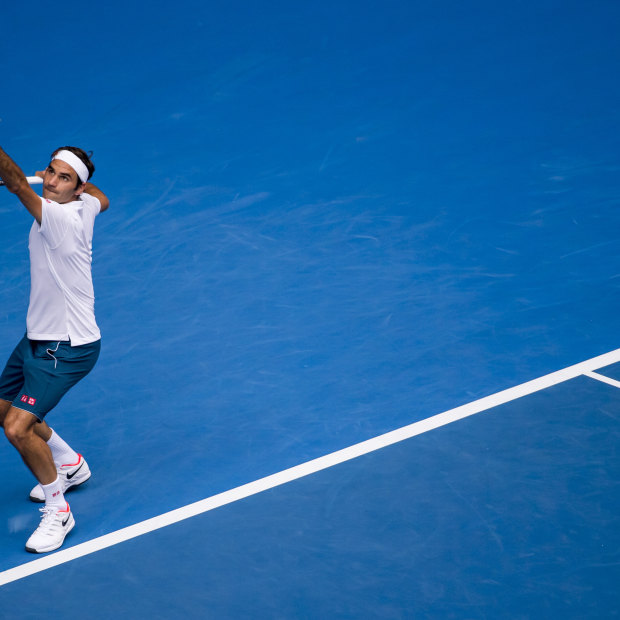
Roger Federer serving at last year’s Australian Open. The Swiss great has been coming to Melbourne for two decades.Credit: Getty Images
There's something about Roger. Something about the way he moves. Some say he floats, which was also said about Muhammad Ali. This is appropriate, because tennis at the highest level, which Roger Federer has been playing over three decades, is boxing with balls: two competitors going at it head to head. Boxing, however, is brutal. Roger adds some ballet.
Roger. One name will do. Like footballers Messi and Ronaldo and Neymar. (Three of the four athletes who raked in more money than him last year.) All around the world, there’s something about Roger that makes spectators go a bit silly. People in the stands – men, women, young, old – holding signs or with painted red-and-white flags even when they’re as Swiss as a didgeridoo.
You’ll see them at the Australian Open. And even though many of those same people would like to see a long tennis drought break with a local winning the Open, there’s something about Roger that could leave them conflicted if he ends up facing Alex de Minaur or, if he can be bothered, Nick Kyrgios.
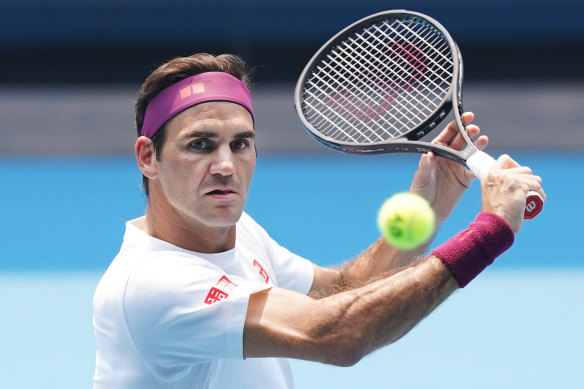
Federer volleys during an Australian Open practice session at Melbourne Park.Credit: AAP
For Australians love him, even though this is a nation with a rich tennis history. Lots of successful players with no-nonsense names: Mark, John, Rod, Ken, Roy, Neale, Pat, Todd, Fred … Ash. In that company, Roger – a name chosen by his Swiss and South African parents because it wasn’t a handful in English – sounds regal. Which is how he’s regarded by most spectators; something that gets up the nose of reigning Australian Open champion Novak Djokovic, a man more respected than loved.
J.M. Coetzee has described his tennis as “something like the human ideal made visible”.
Not only fans revere him. I know a handy club player who owns 11 different Federer racquets. Eleven. He’s like an art student using Rembrandt’s brushes, hoping to paint like him. Roger has prompted literary types to hit high Cs. The late David Foster Wallace wrote: “The thing with Federer is that he’s Mozart and Metallica at the same time.”
J.M. Coetzee has described his tennis as “something like the human ideal made visible”. The man himself has said he finds such hyperbole a bit embarrassing. “At the end of the day I’m just a tennis player.” Correct. And Mozart was just a muso.
Even veteran sports journalists can succumb. Simon Barnes of The Times of London watched Andy Murray lose the 2012 Wimbledon final, then declared: “I have seen leopards hunt, moving as if every joint has been bathed in a gallon of oil and glowing as if lit from within: and that was Federer.”
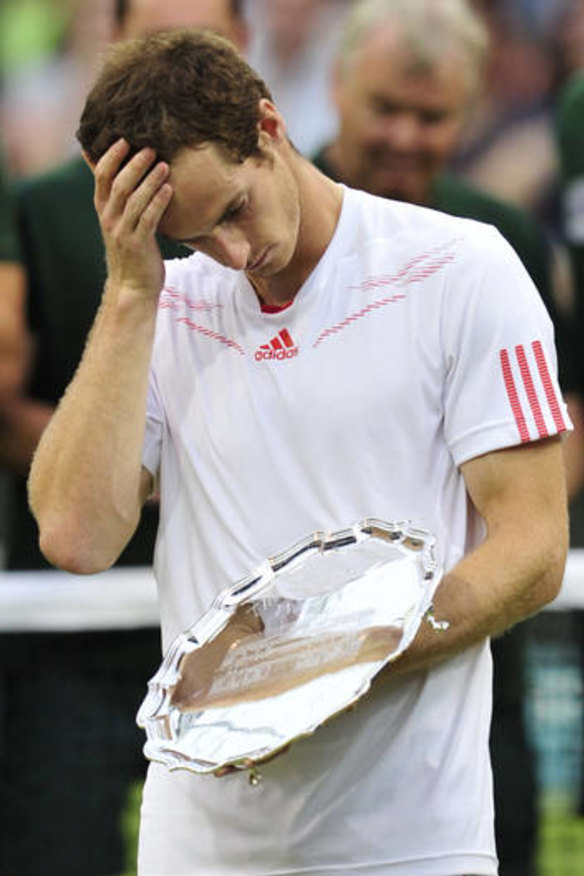
Britain's Andy Murray stands with his runners-up trophy after his 2012 Wimbledon men's singles final defeat to Federer. Credit: AFP
Australian broadcaster and writer Tim Lane confesses to being transported by his tennis. “Victory takes on the sort of nobility I’d once associated with the great sporting heroes of an earlier time … When Federer wins, I feel elated. When he loses, I suffer.” I have shared Tim’s pain.
If Novak isn’t feeling the love as another Open begins, he should understand that Australians have had a much longer relationship with Roger. He’s been rolling up every January since 2000, as much a part of summer as total fire bans. We’ve grown accustomed to his grace. His first Australian Open match, against Michael Chang of the US, attracted little attention.
Federer will turn 39 in August. Since his 2018 Open triumph he has only reached one major tournament final, at Wimbledon last year.
Chang had won the French Open in 1989 at 17. In 1996, he was runner-up in Melbourne. Four years later, Chang lost in straight sets to the headband-wearing 18-year-old Swiss right-hander with imperfect skin and a ponytail. Chang never won a match again in Melbourne. Federer has reached seven finals and won six of them, most recently two years ago. This will be his 21st consecutive appearance.
De Minaur, Australia’s top-ranked male player, is still 20 years old. He says he finds Federer’s longevity inspirational, not annoying. The guy who beat Federer in the fourth round last January, the Jesus-bearded Greek Stefanos Tsitsipas, is 21. Federer will turn 39 in August. Since his 2018 Open triumph he has only reached one major tournament final, at Wimbledon last year. He lost to Djokovic in agonising circumstances.
The on-court shadows are lengthening. Try to catch him over the next fortnight. Because, as the Rolling Stones sang, this could be the last time.
His last Open. His last Australian visit. Possibly his last tournament as the winner of the most men’s Grand Slam singles titles. Federer has held that record since July 2009, when he claimed his 15th Slam, one more than Pete Sampras. He was No. 1, atop the tennis mountain that John McEnroe likened to Everest. But now Spain’s Rafael Nadal is closing in.
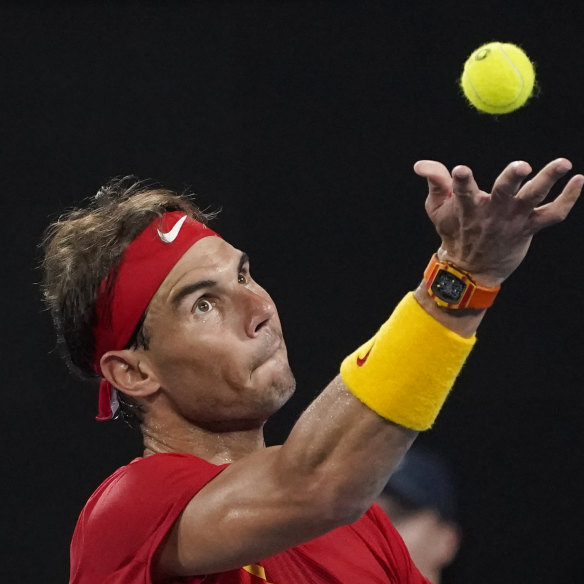
One more grand slam will see Rafael Nadal equal Federer's record number of 20. Credit: AAP
Last year in Melbourne, Nadal was runner-up; one step further will take him to 20 titles, level with Federer. And – the Stones again – time is on his side. For Nadal is almost five years younger. And Djokovic, the most successful player of the last decade, is younger still.
If Federer were to win again this time around, he’d eclipse Ken Rosewall as the oldest-ever champion. And it wouldn’t be a shock: he’s third in the world rankings. This could be the last time. Maybe the last time … Or the start of something special. Again. For he’s good at serving up surprises.
Three Opens ago, he was the 17th seed after taking the second half of 2016 off to fix a bung knee. He hadn’t been ranked so low in Melbourne since 2001; hadn’t won a major title since 2012. Then he rolled Rafa in a five-set final. Six months later he won Wimbledon for the eighth time.
In Melbourne in January 2018 he celebrated back-to-back Opens. By the middle of that year he was No. 1 again, an unprecedented 14 years after first getting there. The entire professional careers of Björn Borg, Pat Rafter and Jim Courier were shorter than that.
Federer is still going, aware that every year he’s closer to the end of the road. Wherever that is. When asked – which he is, often – he insists no dates have been set and he’s not hanging out for a fairytale ending. He reckons the more you contemplate retirement, the closer you are to being there.
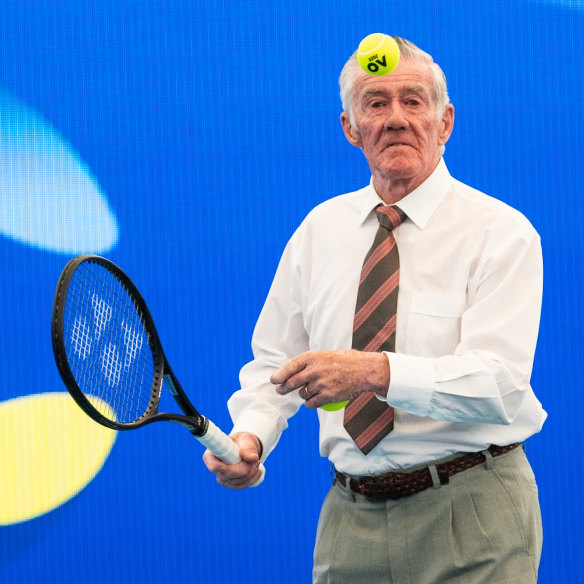
If Federer were to win the Australian Open this time around, he’d eclipse Ken Rosewall as the oldest-ever champion. Credit: AAP
He is planning to play Olympics tennis in Tokyo in July. A gold medal for singles is one of the few prizes missing from his collection: only the mercenary scrapper Jimmy Connors won more tournaments (109) than Federer’s 103.
One theory is that Tokyo gold would mean he has nothing left to achieve. Instead of lingering too long like Ivan Lendl, he could quit while on top like Sampras, whose last professional match was the US Open final in 2002, when he beat his greatest rival, Andre Agassi.
“It was the first really big moment for Roger – dispatching Pete, the greatest champion of the world at that time.”
Rennae Stubbs, Australian tennis player
Both of these Americans have pivotal roles in the Federer story. In July 2001, the 19-year-old Swiss managed something no other player had achieved in five years: he defeated Sampras on centre court at Wimbledon. Federer later confessed he had found it almost unbelievable to see one of his former idols across the net. Then, it was a stunning upset; now, it is clear a baton was handed over that day.
Australian player Rennae Stubbs had a big Wimbledon in 2001, winning the women’s doubles title. But she remembers watching that Federer-Sampras match on TV at her flat in Wimbledon village.
“It was the first really big moment for Roger – dispatching Pete, the greatest champion of the world at that time. I thought, ‘Wow, this guy’s for real.’ And from that moment on, we just knew he was going to be good.”
Federer had hit her radar a few years earlier. “The first I heard about him was Dave Taylor [an Australian coach] telling me about a young guy who Peter Carter was working with. He said, ‘You really have to come and have a look at this guy. He’s unbelievably talented, but a bit of a nut-case on court.’ Which is hard to believe now.”
Former Davis Cup player and team captain John Fitzgerald has a similar memory from 1998, when Federer won Junior Wimbledon. Carter, Federer’s Australian-born coach (who died in 2002), introduced Fitzgerald to “a very friendly, happy kid who was excited about being there”.
Comparisons were already being made with Lleyton Hewitt, six months older. Carter believed his kid would end up doing better. He was right.
Federer himself, sometimes spotted in a Hewitt-style backwards cap early on, never lacked self-belief. In one of his first interviews, with Swiss journalist René Stauffer in 1996, he acknowledged moments of frustration, saying, “One should just be able to play the perfect game.”
He came close against Sampras five years later. In Wimbledon’s interview room, with his straggly hair and beads making him appear more hippie than Hopman, he said, “I thought he was going to return better than he did.” There was a hint of arrogance. Hey Pete, gotta work on your returns, man …
Candour was also evident at the 2005 Australian Open. Both Federer and Agassi swept through the first four rounds to set up a quarter-final clash. The defending champ from Switzerland hadn’t lost a set. In his first match, opponent Fabrice Santoro had sought assistance from a trainer.
In one of his first interviews, in 1996, he acknowledged moments of frustration, saying, “One should just be able to play the perfect game.”
Later, asked about his problem, he replied, “Roger”. But when someone suggested he might need to step up against Agassi, Federer responded, “He’s not as good as he was … I think he has to raise his game, not me.” I was present for that, just as I’d been courtside to watch both men win Australian titles (Agassi four times, Federer once). I wondered what was Swiss-German for “hubris”.
Then I was present on a warm evening to witness Federer dispose of Agassi in a match lasting little more than 90 minutes. If spectators increasingly leaned towards the American – cries of “Come on Andre!” started to sound more desperate – it was only because they wanted a contest.
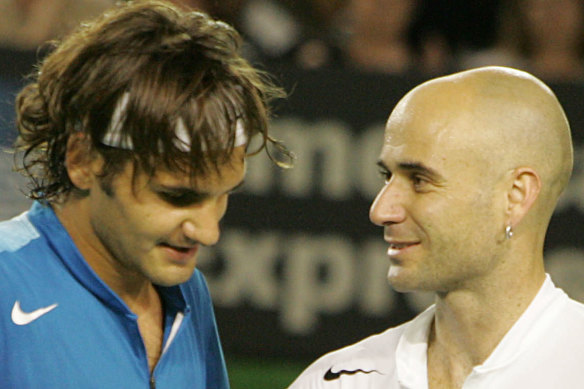
Andre Agassi and Roger Federer's match at the 2005 Australian Open lasted 90 minutes, with Federer the victor.Credit: Wayne Taylor
Reading my match report now, it’s clear I’d succumbed to something about Roger: “Between points and games, Federer walked in an almost lackadaisical manner. Whatever might be simmering inside is seldom allowed to show. And there is something aristocratic in the way he takes opponents apart, slicing them like a musketeer with a razor-sharp blade.”
These guys had history I didn’t fully appreciate then. In 1998, Federer became the world’s top-ranked junior. He also played his first professional tournaments, one being the Swiss Indoor in his hometown, Basel. Four years after being a ball boy there, one year after he’d decided year 9 would be his last at school, he faced Agassi, who’d made his own debut in 1986. The Las Vegas native won 6-3 6-2, saying later the youngster proved “his instinct for the game”. Then came a backhander. “It was an ideal first round: I didn’t have to do that much.”
Agassi was now a believer: “He’s the best I’ve ever played against. He plays this game in a special way. I haven’t seen it before.”
Their subsequent two matches were tighter. In the third, a final in Miami in 2002, Agassi prevailed in four sets against a man he described as being “as hot as anyone on tour”. He’d never win again. The last year of their rivalry, 2005, began with that whitewash in Melbourne and ended with Federer beating him in his second US Open final. Agassi was now a believer: “He’s the best I’ve ever played against,” he said. “He plays this game in a special way. I haven’t seen it before.”
And Agassi had fought them all: Pete Sampras and Boris Becker (Federer’s heroes growing up); Michael Chang; Ivan Lendl; Stefan Edberg; Pat Rafter. For Agassi, the Swiss topped the lot. Not because of results, but his style.
That’s the thing about Roger. You can get lost in a flurry of statistics: number of titles; his resilience in a gruelling sport; No. 1 for longer than anyone (310 weeks in total) and most consecutive weeks (237); career prizemoney (close to $US130 million). But numbers don’t tell the real story. There is something about Roger that can’t be quantified. Not what he’s done, but how he does it.
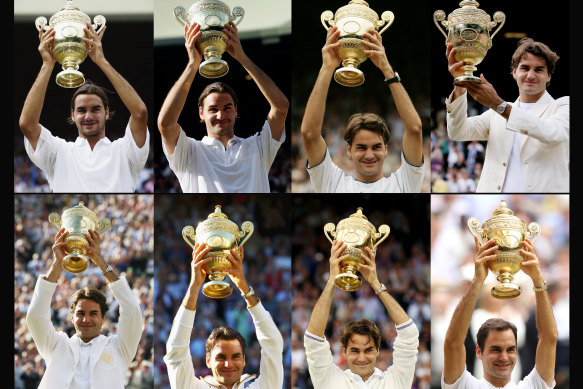
Federer’s winning ways at Wimbledon. From top left in 2003, 2004, 2005, 2006, 2007, 2009, 2012 and 2017.Credit: Getty Images
David Foster Wallace called them Federer Moments: “Times … when the jaw drops and eyes protrude.” I know what he meant. It was in 2005, witnessing Federer crush Agassi on an olive-green court, that I realised I was gasping at the improbability of some shots.
You’re not meant to gasp in the press seats: nobody else I’d seen up close had ever made me do that. Of all the other players I’d seen play over three decades, including a stint as tennis writer for The Age in the mid-1990s, John McEnroe came closest. And Mac himself said in 2003: “I dreamed of playing like Federer. Watching him play is the greatest treat.” Though not for opponents.
After losing the 2004 Australian Open final, Marat Safin shrugged and said, “I’ve just lost to a magician.” Tsitsipas, who prevailed again in Federer’s last official match for 2019, was sufficiently respectful to say: “This guy does magic on the court.”
Early on, he tamed his temperament out of pragmatism, recognising that tossing racquets and/or tantrums was draining.
There’s another word often used about him: “genius”. After the 2012 Wimbledon final, former pro player Sue Barker began her on-court interview by suggesting he’d played “genius tennis”. He didn’t disagree. But the flip side of this is that he has raised the bar almost impossibly high. Anything less than success represents failure.
One of his first coaches (after Carter) was Swede Peter Lundgren. Journalist René Stauffer quotes him as saying: “He is an artist and when his strokes don’t work, he becomes irritated and loses his concentration.”
Early on, he tamed his temperament out of pragmatism, recognising that tossing racquets and/or tantrums was draining. “For the sake of winning, I changed my attitude,” he told David Remnick of The New Yorker last August. Kyrgios, take note.
The pursuit of perfection can be painful. He cares, deeply, which is why spectators care about him. His almost spooky impassiveness on court, the way it is virtually impossible to tell from his expression or body language if he is up or down, masks emotional intensity. He has wept after a victory, as he did after dethroning Sampras in 2001. Then again in Melbourne five years later after being handed his second Australian Open trophy by Rod Laver, a man who also understood the pressure of expectations.
“They’re very, very different players. You’ve just got to admire their qualities: Roger’s elegance and style, Rafa’s fighting spirit.”
Alex de Minaur, Australian tennis player
He has also broken down after defeats, most dramatically 11 summers ago after losing a long Australian Open final to Nadal. “God, this is killing me,” he blubbed. It was not clear if he was affected most by the crowd’s support or the realisation that the Spaniard – a snarling, relentless warrior with a little-boy smile only seen off court – had his measure. Each of his five Grand Slam final losses up to then had been to Nadal.
That’s something about Roger that underscores his appeal: fragility. Things can go wrong. Mozart hits a bung note on the piano. He is a man, not Superman. Asked if, when growing up, he’d been a Federer or Nadal guy (people tend to take sides), Alex de Minaur replies, “They’re very, very different players. You’ve just got to admire their qualities: Roger’s elegance and style, Rafa’s fighting spirit.”
And the thing about sport is if you keep playing, you get more chances to win. Throughout Federer’s career, some of the deepest valleys have been followed by mountain tops as glorious as anything in Switzerland. Similarly, defeats can lead to a string of victories. In September 2003, Hewitt handed Federer one of his most painful losses in a Davis Cup semi-final. Lessons learnt, the Swiss prevailed in their next 15 matches.
In July 2009, six months after his public meltdown in Melbourne, Federer claimed the French Open crown in Paris. Thrice previously, Nadal had ground him into the Roland Garros clay. But in 2009 something extraordinary happened. Nadal lost. In the final, Federer faced not his nemesis but rather the Spaniard’s conqueror, Robin Söderling. When he won he sank to his knees on the court. Later, of course, he cried. In a neat sequel to their rivalry, the French trophy was presented to him by Agassi. They were now both members of a select group to have triumphed at all four Grand Slams.
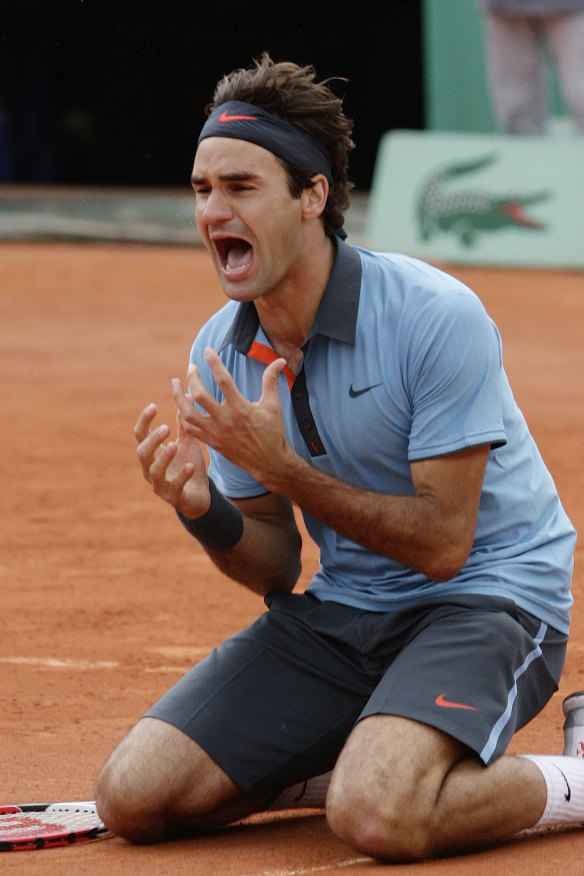
Federer's jubilation is clear as he finally wins the elusive French Open in 2009. Credit: AP
Yet there’s a crucial difference between them. Agassi hated tennis “with a dark and secret passion”. Kyrgios and Bernard Tomic have expressed variations on this theme. Federer loves it now; loved it then. In 1999, sporting bleached-blond hair, young Roger told an interviewer: “I do enjoy the game a lot. I do like to play tennis.”
Though, he added, he preferred matches to practise sessions. Still does. And he loves being one of the boys, sometimes a bit of a goofball. He was caught on camera thumping bongos during the Hopman Cup in Perth in 2017. Two months later, he got together with fellow players Grigor Dimitrov and Tommy Haas to warble a woeful version of Chicago’s soppy Hard to Say I’m Sorry with grand-piano accompaniment during the Indian Wells tournament. (Really, Roger, Chicago? After once being an AC/DC fan?)
Maria Sharapova, like Federer a 2004 Wimbledon champion, is notoriously icy in the locker-room. Not him. To Rennae Stubbs, this explains a lot. “Roger is the type of guy who always loved the game of tennis. That’s why he’s still playing. He knows who’s playing, whether it be singles or doubles or mixed; he’s aware of what’s going on. This is a guy who recognises how lucky he is as a person and also as a tennis player. He loves everything about it – the wins and the losses.”
Ah yes, the losses. There’s something about Roger that means his losses can increasingly seem more memorable. Also more painful. Not just for him.
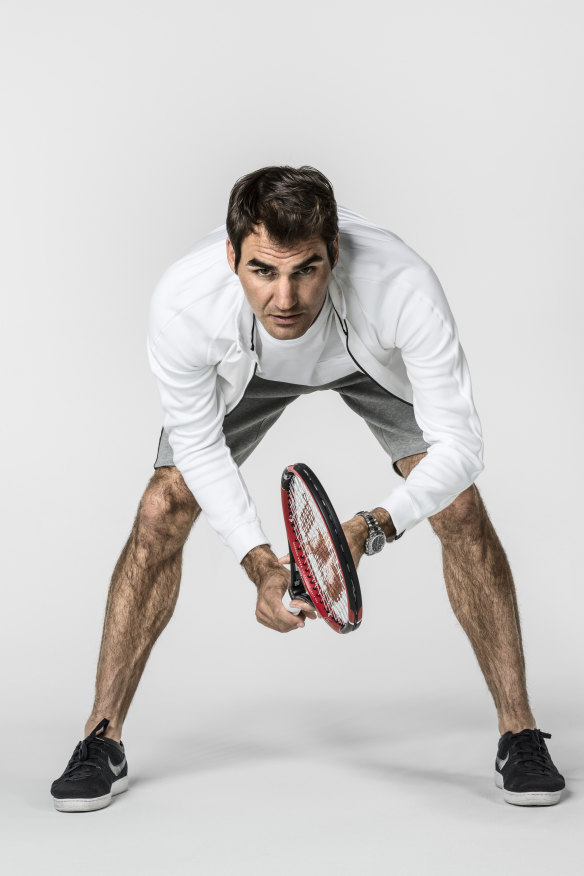
The thing about Roger is you can get lost in a flurry of statistics including the number of titles and his resilience in a gruelling sport.Credit: Mathias Braschler & Monika Fischer/AUGUST/Raven & Snow
"I don't know how long I’ll need to get over this defeat: a day, a week, a year, or my entire career.” So said 21-year-old Roger in Paris in 2003 after losing a first-round match to Peruvian Luis Horna. Few remember Horna now. Or that match. Roger got over it soon afterwards by becoming Wimbledon champion. Another mountain after a valley.
So maybe there’s no need to brood about Wimbledon 2019. The final I couldn’t bring myself to watch for months afterwards. This would be a more embarrassing confession if Federer himself hadn’t said recently that he gets more nervous watching sport – a Swiss football match, for example – than playing it. For me, it’s not nerves so much as a fear of seeing the natural order undone. Technical skill triumphing over artistry. There’s something about watching Roger’s matches live on TV that can make me groan as well as gasp.
Once I knew he’d lost the longest men’s final ever, I didn’t need to see it. Or the two match points he’d held – two! – on serve in the 16th game of the fifth set. I lost sleep pondering them. He’d sent down 56 aces reaching the final; another 23 to get within a single point of his ninth Wimbledon crown and 21st major title. Just one more – one! – could have achieved that and put wife Mirka out of her palpable agony. Plus give us a happy ending.
The woman born Miroslava Vavrinec in what was then Czechoslovakia (her family moved to Switzerland when she was two) first took notice of him when they were both members of the Swiss tennis team at the Sydney Olympics in 2000. He was funny, she thought. Also three years younger. Injuries ended her own playing career in 2002. After that, she has said, “Roger gave my tennis life back to me. When he wins, it’s as if I win as well.” But when he’s close to winning, as he was at Wimbledon last July, it is excruciating. She is as animated as her husband of nearly 11 years is stony-faced.
It was what Mirka was going through that struck me most when I finally watched those two missed match points. Also his dad, Robert, a tennis enthusiast who used to work for a chemicals company, wearing one of his son’s RF caps to shield him from the late-afternoon sun: silent; stoic. And the ubiquitous Fed Fans in the crowd standing with one finger raised. So close, and yet …
Federer lost his first match point with a skewed forehand; Djokovic won the second with a forehand cross-court winner almost identical to the one thatthe crowd favourite had conjured to break him in the previous game. Tennis is like that. Matches can balance on a knife-edge near the end. Success means seizing moments.
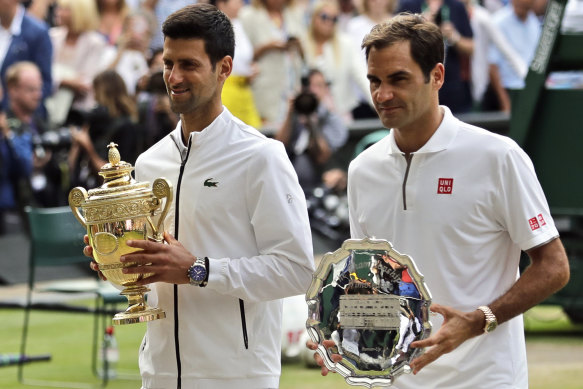
Federer's loss over Novak Djokovic at last year's Wimbledon was difficult to watch for his fans after having two match points. Credit: AP
I didn’t watch much more after Djokovic survived his near-death experience. I knew how this story ended: the Serb munching a few blades of court grass; Federer just sitting there, not weeping, struggling to comprehend it all. Stunned. But I had to ask Tim Lane, who has been known to turn off a TV to change the course of a Federer match, what he’d thought.
“I hadn’t expected him to win, so had a range of responses,” Lane says. “I was delighted he played so well. I was in awe of Djokovic’s remarkable capacity to play so unerringly when looking down the barrel. And absolutely gutted. Also left wondering whether the chance might ever come again.”
Federer himself might have moved on already. After the match, asked about comparisons with another epic five-set Wimbledon final, against Nadal in 2008, he said: “I’m the loser both times, so that’s the only similarity I see.” He managed a rueful smile, which was a healthy sign. He’d also remembered to put on his sponsor Rolex’s watch: taking care of business even when deep in a dark valley.
Then he went off camping with Mirka and their children: two sets of identical twins; first girls, then boys (turning 11 and 6, respectively, this year). Four children: perfect for a doubles game. And for distracting yourself. The whole gang often travel with him – giving him stability. (Although his 2017 knee problems stemmed from a slip during kiddy bathtime.)
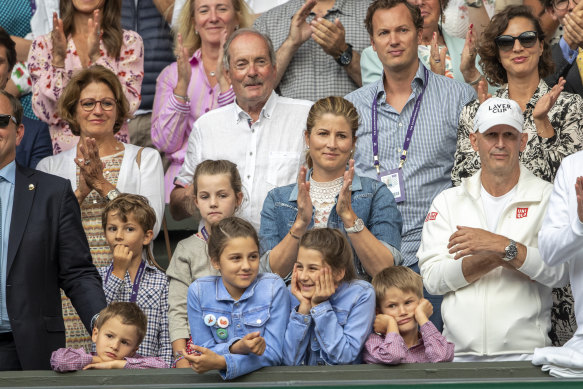
Federer’s wife, Mirka (centre), with (at front) their twin girls, Charlene and Myla, and twin boys, Lenny and Leo.Credit: Getty Images
That Wimbledon final could yet be the prelude to something wonderful. He’s already played Djokovic again, in London in November at the ATP Finals. He won. A clenched fist and cry of exultation at the end showed it meant something. Not redemption, but proving something to himself. It also meant that Nadal, not Djokovic, would end 2019 as No. 1.
But when will someone else hit that peak? Someone like Tsitsipas or Alexander Zverev, who is 22 and played Federer in Shanghai late last year. The young German prevailed, but not before Federer saved a handful of match points. Including three in a row on Zverev’s serve: a sequence of shots that led a commentator to exclaim, “Insanely good!” You can find match highlights on YouTube under a heading: “When Federer hits GOD MODE.”
Late in November, Federer played Zverev again in a string of meaningless but lucrative exhibition matches in Mexico and South America, presumably raising money for his philanthropic foundation. This diversion raised eyebrows, as it coincided with the rejigged Davis Cup being contested in Spain. There’s something about Roger that can piss people off – not least a feeling that he is bigger than the game.
What else can be used against him? Let’s start with the custom-made cream jacket and matching long trousers that he wore at Wimbledon in 2009, making him look like a plonker who’d strolled in from Gatsby’s garden party. Then there’s the way he’s become a brand. Forbes estimates he raked in $US93.4 million last year, of which $US86 million came in endorsements. Sponsors want bang for their bucks. They can offer access, but with more strings attached than you’d find in his racquets.
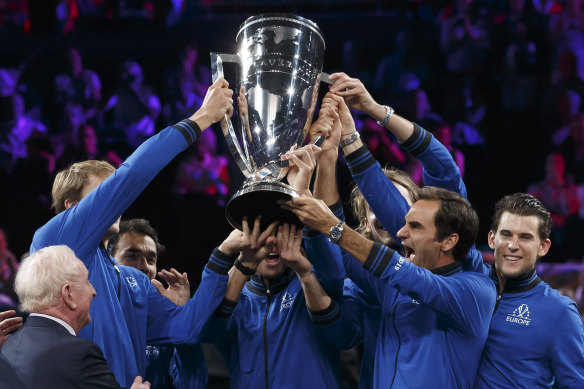
Criticisms against Federer include he's involved in too many ventures, such as the Laver Cup. Credit: AP
His association with Credit Suisse, accused of investing in oil and coal, recently put him offside with environmental activists including Greta Thunberg, who endorsed #WakeUpNowRoger.
He makes too many ads: on ABC TV recently, panellists on Gruen mocked a pasta commercial. He’s no actor (or singer), but he keeps getting asked to do ads because of his worldwide appeal. He also has his fingers in too many pies, including the Laver Cup (more competition for Davis Cup) and sports agency TEAM8, which numbers among its clients Zverev and the American teen sensation Coco Gauff.
Such things can be raised, only for Roger and his fans to dismiss them like an easy volley. Once, he was paired with golfer Tiger Woods. (Watch him: Roger sometimes hits the ball with the edge of his racquet before serving, just like Tiger bouncing a ball on a club face.) But then Tiger’s energetic private life made worldwide headlines and his marriage imploded. Federer, meanwhile, continues to star in his own long-running version of Family Guy.
De Minaur says “he’s one of the nicest guys – always saying 'Hi' at tournaments”. Fitzgerald even tells a story about seeing Federer, with family and friends, in the players’ lounge during an Australian Open. The champ himself later cleared away plates and cutlery, making two trips to hand things over to awe-struck waitresses. Having cleaned up, he wandered off.
In my heart I just like playing tennis; practise or matches. I like being out there.
Roger Federer
When will he walk away for good? It’s a tricky question. “Retirement is a truly individual thing,” says Stubbs, who started at a similar age and began her final year on the circuit (2011) at 39.
“For some people it’s about injuries. They can’t force themselves to go through rehab again, or can’t force themselves to go through pain. Sometimes it’s about wanting to have a family: obviously that’s not his problem. Sometimes, you just don’t have the desire – as happened with Steffi Graf [who retired in 1999, aged 30, and is married to Agassi]. For Roger, it’ll be when the joy just isn’t there for him to go and hit practice balls … Or that same love when he walks on the court.”
John Fitzgerald, a pro for 17 years, says tennis “has been fortunate to have Federer and Nadal … They will know how much it hurts to not be as good as they were, and to lose in earlier rounds. They will know when the time’s right, but the short answer is, it’s their prerogative. They deserve to go when they want to go.”
Federer himself has been talking like a man not going anywhere except the next court. Sounding just like the blond dude from 1999, he told David Remnick 20 years later: “In my heart I just like playing tennis; practise or matches. I like being out there.” His motivation? Can be records, proving something to himself, beating the new guys …
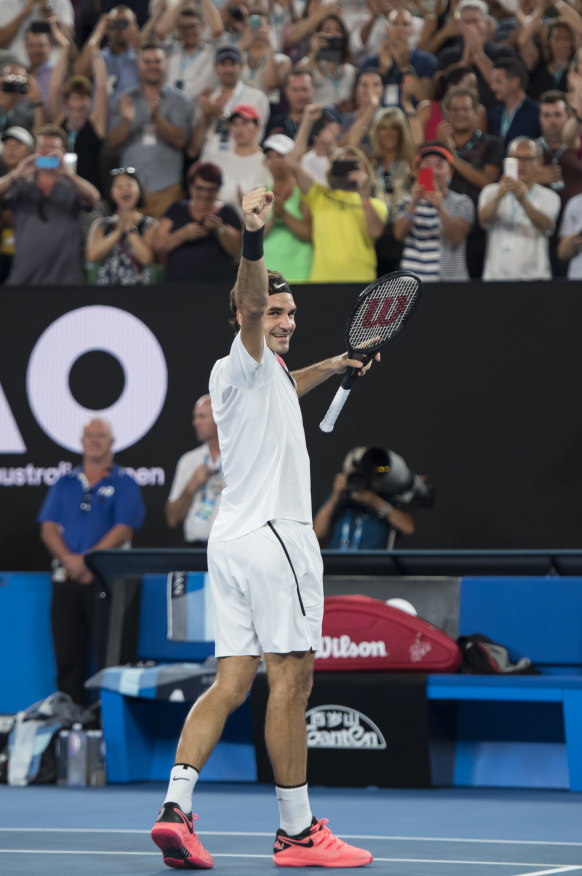
Federer beats Croatia’s Marin Cilic in five sets to claim the 2018 Australian Open.Credit: Getty Images
Late in October, Federer returned to Basel for another Swiss Open. His opponent in the final was Alex de Minaur. The 20-year-old Australian clinched his first on-court meeting with the guy he once loved to watch play by beating American Reilly Opelka, a winner of Junior Wimbledon 17 years after Federer. The final was over in 68 minutes, the local hero winning 6-2, 6-2. “That was amazing,” de Minaur said. Holding the trophy that already had his name on it nine times, Federer told the runner-up: “You’re only going up from here.”
Two months later, back in Australia again, de Minaur takes time out to reflect on that match. Had he – like Federer against Sampras – found it disconcerting to see a former idol across the net? “My goal, definitely, was to look at it as any other match,” he says. But then Federer conjured shots that made him think: “Jesus Christ, that was good. What the hell am I supposed to do with that?” Federer’s speed and anticipation surprised him. The older man seemed to have time on his side.
At the post-match ceremony in Basel, Federer stood with the trophy in a blizzard of gold foil. Nearby, like something from a tacky TV game show, were huge numerals spelling out “10”. The winner declared, “I couldn’t be happier,” which explained the tears. Both the hoopla and Federer’s response seemed a bit over the top. But perhaps he and tournament officials and everyone else present had an inkling of the possible significance of what was unfolding. This could be the last time. Maybe the last time … I don’t know.
To read more from Good Weekend magazine, visit our page at The Sydney Morning Herald, The Age and Brisbane Times.